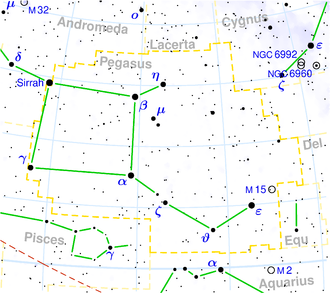IC 1380
| Galaxie IC 1380 | |
|---|---|
 | |
| AladinLite | |
| Sternbild | Pegasus |
| Position Äquinoktium: J2000.0, Epoche: J2000.0 | |
| Rektaszension | 21h 27m 11,0s[1] |
| Deklination | +02° 43′ 04″[1] |
| Erscheinungsbild | |
| Morphologischer Typ | C[2] |
| Helligkeit (visuell) | 14,3 mag[2] |
| Helligkeit (B-Band) | 15,3 mag[2] |
| Winkelausdehnung | 0,3′ × 0,3′[2] |
| Flächenhelligkeit | 11,5 mag/arcmin²[2] |
| Physikalische Daten | |
| Rotverschiebung | 0.042429 ± 0.000123[1] |
| Radialgeschwindigkeit | 12.720 ± 37 km/s[1] |
| Hubbledistanz vrad / H0 | (576 ± 40) · 106 Lj (176,5 ± 12,4) Mpc [1] |
| Geschichte | |
| Entdeckung | Stéphane Javelle |
| Entdeckungsdatum | 3. Oktober 1891 |
| Katalogbezeichnungen | |
| IC 1380 • PGC 66779 • CGCG 375-035 • 2MASX J21271100+0243033 • GALEXASC J212711.04+024304.7 | |
IC 1380 ist eine kompakte Galaxie vom Hubble-Typ C im Sternbild Pegasus am Nordsternhimmel. Sie ist schätzungsweise 576 Millionen Lichtjahre von der Milchstraße entfernt und hat einen Durchmesser von etwa 50.000 Lj.
Im selben Himmelsareal befinden sich u. a. die Galaxien NGC 7077, NGC 7081, IC 1379, IC 5111.
Das Objekt wurde am 3. Oktober 1891 von Stéphane Javelle entdeckt.[3]
Weblinks
Siehe auch
Einzelnachweise
Auf dieser Seite verwendete Medien
Autor/Urheber: Sloan Digital Sky Survey, Lizenz: CC BY 4.0
The sky image is obtained by Sloan Digital Sky Survey, DR14 with SciServer.
Angle of view: 4' × 4' (0.3" per pixel), north is up.
Details on the image processing pipeline: https://www.sdss.org/dr14/imaging/jpg-images-on-skyserver/



